Highly Experienced Physiotherapists, Revolutionary Approach
Don't wanna be here? Send us removal request.
Text
Active vs. Passive Recovery: Which One Does Your Body Need?

Recovery is where growth happens, but are you giving your body the right type? Most overlook recovery until fatigue, pain, or plateaus strike. The key isn’t choosing between “train harder” or “rest more” it’s understanding when to use active vs. passive recovery.
What Is Passive Recovery?This is full-body rest: sleep, massage, breathwork, cryotherapy. It lets your nervous system reset and your muscles repair. Use it after intense workouts, during illness or injury, or when your body is deeply fatigued. Sleep remains your most powerful recovery tool.
What Is Active Recovery?Low-effort movement like walking, Pilates, or foam rolling that keeps blood flowing without overloading your body. It reduces soreness, flushes out waste, and maintains mobility. At TSquared, we build active recovery into high-frequency training and rehab programs.
When to Choose WhatBurnt out? Go passive. Tight but restless? Go active. Post-lifting day? Combine both. Injury rehab? Follow a guided blend.
The Hybrid ModelMost clients benefit from a weekly mix: 2-3 days active, 1-2 days passive, plus good sleep and nutrition.
Train Smarter, Not Just HarderRecovery isn’t optional, it’s where transformation begins. Want better results? Learn when to pause and when to move.
👉 Read the full post: https://tsquaredlab.com/blog/active-vs-passive-recovery/
0 notes
Text
Understanding the Stages of Rehabilitation: What Happens During Your Recovery Journey

Recovery isn’t linear, and not knowing what to expect can make it even harder. At TSquared Physio, we guide you through four essential stages of healing, rebuilding not just your body, but your confidence.
Stage 1: Protection & Inflammation (Days 1-7)
Your body kicks off healing with inflammation. We help reduce excessive swelling, protect the area, and gently maintain range of motion; movement (not just rest) is key.
Stage 2: Repair & Early Activation (Days 5-21)
Pain reduces, but stiffness and weakness remain. We restore basic mobility, reactivate muscles, and correct compensations, while laying the foundation for long-term recovery.
Stage 3: Strengthening & Motor Control (Week 3-8)
The hard work begins. Through progressive loading and neuromuscular training, we build strength, endurance, and control, preventing re-injury before you feel ready.
Stage 4: Functional Integration & Return to Performance (Week 6-12+)
Whether it’s sport, parenting, or daily tasks, we ensure strength meets real-world function. Think power, agility, postural endurance, and confidence in your body again.
Rehabilitation is not just about healing an injury; it’s about coming back stronger, smarter, and more self-aware. When done right, physiotherapy doesn’t just fix problems. It upgrades the way you move through life.
Read the article: https://tsquaredlab.com/blog/understanding-the-stages-of-rehabilitation/
0 notes
Text
Why Men’s Health Matters: How Physiotherapy Supports Prostate Health and Pain Management

Men’s health is often narrowly associated with fitness or cardiovascular disease, but rarely does the conversation go deeper into the issues like that silently affect quality of life. Prostate health, pelvic pain, postural dysfunction, and chronic musculoskeletal tension are just a few examples of issues men face.
At TSquared Physio, we’re changing the narrative. Because ignoring the signs isn’t strength, early intervention is.
Prostate Health and the Pelvic Floor Connection
Most men don’t even know they have a pelvic floor. But issues like BPH, prostatitis, or recovery from prostate surgery can seriously affect bladder control, comfort, and confidence. The right physiotherapy can restore tone, reduce symptoms, and bring back control.
Managing Chronic Pain in Men
Low back pain, sciatica, stiff hips - these often trace back to postural dysfunction and muscular imbalance. Painkillers and “rest” won’t solve the issue. We treat the root cause, not just the symptom.
Mental Health, Physical Tension, and the Male Experience:
Clenched jaw. Tight hips. Shallow breathing. That’s not just soreness, it’s somatic stress.
Physiotherapy helps release chronic tension and connect the mind and body. The benefits ripple into sleep, digestion, and mood.
Men’s health deserves more attention and a more complete approach.
👉 Read the full article to learn how physiotherapy supports better movement, fewer symptoms, and healthier ageing: https://tsquaredlab.com/blog/mens-health-physiotherapy-prostate-health-pain-management/
0 notes
Text
A Deep Dive into Stretch Therapy: The Science of Moving Better, Recovering Smarter, and Living Pain-Free

In fitness, we often chase progress, numbers, and intensity, while skipping the one thing that could keep us moving well, pain-free, and injury-resistant: stretch therapy.
This isn’t just passive stretching. It’s a structured, practitioner-led system that rewires how your body moves by:
Releasing deep muscular and fascial tension
Restoring range of motion
Rebalancing movement patterns
Supporting nervous system recovery
Stretch therapy doesn’t just make you more flexible; it helps you move in a way that aligns with your body's natural structure. Whether you’re lifting weights, recovering from injury, sitting at a desk all day, or navigating hormonal shifts, this work is essential.
And the science backs it:
PNF and assisted stretching retrain the brain to allow safer, deeper movement
Breathwork activates the parasympathetic system, improving recovery
Fascia becomes more hydrated, elastic, and resilient
You reduce your risk of injury and move with less compensation
Stretch therapy is not yoga. It’s clinical, targeted, and precision-guided, built for your body’s specific tension patterns and postural habits.
This is about function, not just flexibility. It’s how you prevent tight hips from becoming lower back pain. How you recover smarter, move longer, and live stronger.
Want to age gracefully, recover better, and move with freedom? Read the full article: https://tsquaredlab.com/blog/deep-dive-into-stretch-therapy/
0 notes
Text
Recovery and Regeneration: The Most Overlooked Pillars of Progress

In today’s results-driven fitness culture, recovery is often sidelined, viewed as passive or optional. But the truth is, no transformation is complete without it. This blog dives deep into the science and strategy of recovery and regeneration, revealing why these are not luxuries but the backbone of sustainable progress.
From the cellular processes behind muscle repair and nervous system reset, to the role of sleep, nutrition, active recovery, and personalised modalities, this comprehensive guide shows how your body rebuilds not during training, but between it. We also clarify the difference between short-term recovery and long-term regeneration, while challenging popular misconceptions about recovery tools like ice baths, infrared saunas, and foam rolling.
Whether you're an athlete, a working professional, or simply someone who wants to feel better, move better, and train longer, this blog offers a practical, science-backed roadmap to help you recover smarter, prevent burnout, and perform at your peak, year after year.
Read the full article: https://tsquaredlab.com/blog/recovery-and-regeneration/
0 notes
Text
Pilates and Strength: The Mind-Body Connection Women Need

In a world where fitness often swings between extremes, high-intensity workouts on one end, restorative yoga on the other, Pilates offers something rare: strength built on control, precision, and breath.
More than “just stretching,” Pilates is a proven system of movement that:
Builds core strength, posture, and flexibility
Activates deep stabilisers like the pelvic floor, glutes, and transverse abdominis
Improves neuromuscular awareness for safer, more powerful lifts
For women at any life stage - from postpartum recovery to post-menopause, these benefits are essential. It supports:
Hormonal regulation and joint stability
Recovery from diastasis recti
Reduction in pain caused by weak stabilisers
Unlike strength training alone, Pilates teaches you to move with intention, not just effort. The result? Fewer injuries, better form, and long-term mobility.
Mentally, it’s a reset. Pilates helps regulate the nervous system, reduce stress, and rebuild self-trust through conscious movement.
It's not about doing more. It's about doing better.
👉 Read the full article: https://tsquaredlab.com/blog/pilates-and-strength-for-women/
0 notes
Text
Understanding Dry Needling: A Powerful Tool for Pain Relief and Recovery

If you've been struggling with muscle pain, stiffness, or slow recovery, dry needling could be the solution you’ve been looking for. This advanced technique is gaining popularity among physiotherapists and sports medicine professionals for its ability to relieve pain, enhance mobility, and accelerate healing.
Dry needling works by targeting muscle knots and trigger points using sterile needles to release tension, improve circulation, and support your body’s natural recovery process. Whether you're an athlete, dealing with chronic pain, or recovering from an injury, this treatment can help you move and feel better.
At TSquared Physio, our expert therapists provide tailored dry-needling treatments to ensure safe, effective, and results-driven care. If you’re ready to experience long-term pain relief and improved movement, we’re here to help.
Read the full article: https://tsquaredlab.com/blog/understanding-dry-needling/
0 notes
Text
The 5 Injury Prevention Mistakes Athletes Make (and How to Avoid Them)

As athletes, we constantly push our bodies to achieve peak performance. However, with the thrill of competition comes the risk of injuries that can sideline us for weeks or even months. Fortunately, most sports injuries are preventable with the right approach.
Let’s talk about five mistakes athletes make and how you can steer clear of them to stay healthy and perform at your best.
✨5 Key Mistakes to Avoid:
Skipping Warm-Ups and Cool-Downs: Proper prep reduces strains and enhances recovery.
Neglecting Technique: Incorrect form increases injury risks.
Ignoring Strength & Flexibility Training: Balance training is vital for joint stability and range of motion.
Overtraining: Rest days are just as important as workouts!
Using the Wrong Gear: Ensure proper footwear and protective equipment.
🏆 Pro Tip: Consistency and awareness are the keys to staying injury-free. Don’t let avoidable mistakes hold you back.
Read the full article to learn how to protect yourself and perform at your best!
0 notes
Text
Can You Build Muscle with Pilates Reformer?

Can You Build Muscle with Pilates Reformer? We debunk the myths and reveal the muscle-building truth in our latest blog. Discover how controlled movements and resistance on the reformer can help you sculpt lean, toned muscles and transform your physique. 💥
🧘♂️ Understand the Science: Learn how Pilates reformer creates muscle growth through time under tension, muscle endurance, and variable resistance.
🏋️♀️ Effective Routines: Explore Pilates reformer routines targeting upper body, lower body, core, and full-body development.
🌟 Maximise Gains: Discover strategies like progressive overload, variety in workouts, proper nutrition, and the importance of rest for muscle growth.
Ready to embrace a stronger, leaner you? Dive into our blog and unleash your muscular potential with Pilates reformer. 💥
Read the Blog and join us on this fitness journey.
0 notes
Text
The Science Behind Synergy: How Osteopathy and Physiotherapy Support Recovery
Combining osteopathy and physiotherapy offers a holistic approach to recovery, improving mobility, reducing pain, and building long-term health.
✨ Key Highlights:
Osteopathy: Focuses on realigning the body with manual techniques to promote natural healing.
Physiotherapy: Targets injuries and strengthens specific areas with customised exercises and therapies.
Complementary Benefits: Together, they ensure faster healing, structural alignment, and functional recovery.
💡 Whether it’s chronic pain, sports injuries, or post-surgical care, this powerful combination provides a complete path to wellness.
💪 Read this entire article and Take the first step to recovery
0 notes
Text
🌟 Managing Chronic Pelvic Pain with Physiotherapy 🌟

Chronic pelvic pain (CPP) affects millions, impacting daily life, mobility, and emotional well-being. Physiotherapy offers effective, non-invasive solutions to manage pain and improve quality of life.
✨ Here’s How Physiotherapy Can Help:
Pelvic Floor Rehabilitation: Techniques like manual therapy and trigger point release relieve tension and discomfort.
Pain Relief Techniques: Deep breathing and guided imagery calm the nervous system and reduce pain perception.
Stretching Exercises: Gentle stretches improve flexibility in the pelvic floor, lower back, and hips.
Therapeutic Exercises: Core strengthening, Kegels, and low-impact activities enhance stability and function.
Electrical Stimulation: Tools like TENS devices help block pain signals and restore muscle coordination.
💡 Top Benefits of Physiotherapy for CPP:
Significant pain reduction.
Improved pelvic functionality and mobility.
Enhanced quality of life with reduced reliance on medication.
Chronic pelvic pain doesn’t have to hold you back. Physiotherapy empowers you to take control, relieve pain, and live life fully.
💪 Read the entire blog to learn more.
2 notes
·
View notes
Text

Physiotherapy is no longer just about healing injuries; it’s a game-changer for athletes aiming to optimise their performance. Here’s how:
✨ Key Benefits for Athletes:
Optimised Movement: Advanced techniques like motion capture technology, force plates, and Functional Movement Screening (FMS) help analyze movement mechanics, assess balance and power output, and identify imbalances or weaknesses that could hinder performance or increase the risk of injury.
Enhanced Flexibility: Techniques like PNF and myofascial release improve mobility and prevent injuries.
Injury Prevention: Prehabilitation strengthens muscles and joints, reducing the risk of sports-related injuries.
Faster Recovery: Methods like cryotherapy and active recovery alleviate fatigue and muscle soreness.
Mental Edge: Physiotherapy boosts confidence, resilience, and readiness for competition.
Whether it’s addressing weak points, correcting muscle imbalances, or building core strength, physiotherapy empowers athletes to achieve their best on and off the field.
💪 Ready to discover the secrets to sustained athletic excellence? 👉 Read the full article now and enhance your game! #SportsPhysio #AthleticPerformance #InjuryPrevention #PeakPerformance
0 notes
Text
Benefits of Physiotherapy for Treating a Sprained Ankle

A sprained ankle is quite a common injury that can cause pain, swelling, and limited mobility. While rest and ice are initial treatments, physiotherapy offers a comprehensive approach to healing and rehabilitation. To alleviate the symptoms of a sprained ankle, you need to be patient and work with physiotherapy on your fingernails. And that is what would give you a place where the sprained ankle would eventually heal.
In this blog, we'll explore the five key benefits of physiotherapy for treating a sprained ankle, highlighting its effectiveness in promoting recovery and preventing future issues.
The 5 Benefits of Physiotherapy for Treating a Sprained Ankle
You can treat a sprained ankle in a lot of different ways but what is chosen the best is, choosing to treat it with physiotherapy. There are certain reasons why we recommend that. Let’s see into it:
Pain Management
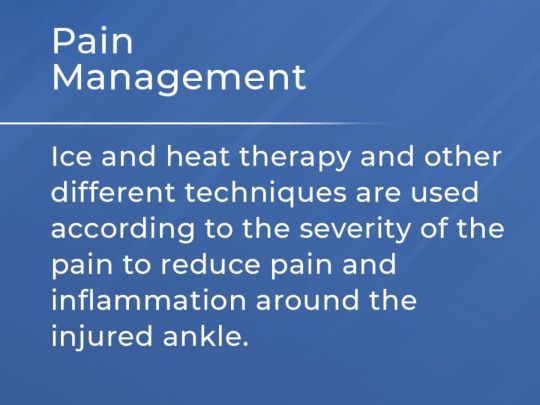
Physiotherapy actually employs various techniques to manage pain associated with a sprained ankle, including manual therapy, modalities such as ultrasound or electrical stimulation, and therapeutic exercises. By addressing pain early in the recovery process, physiotherapy helps patients regain comfort and mobility more quickly.
Prevents Joint Stiffness
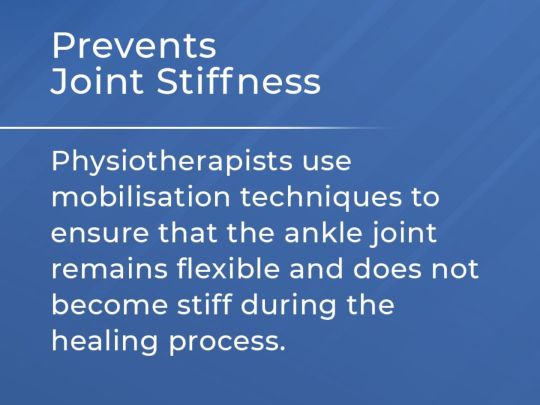
You might face the issue of an immobilized ankle. Such an ankle might come following a sprain and can lead to joint stiffness and decreased range of motion. The job of physiotherapy is to focus on preventing stiffness through gentle mobilization exercises and stretching routines. By maintaining flexibility and joint mobility, physiotherapy ensures a smoother recovery and reduces the risk of long-term complications.
Enhances Functional Abilities

Restoring functional abilities, such as walking, standing, and balance, is a primary goal of physiotherapy for sprained ankles. Through progressive exercises and functional training, physiotherapists help patients regain strength, stability, and coordination, enabling them to return to their daily activities with confidence.
Customized Treatment Plans
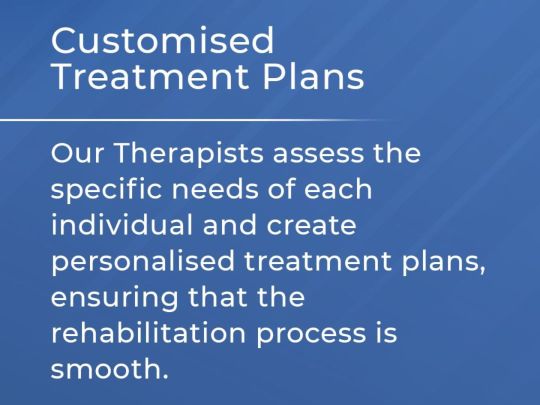
Physiotherapy for a sprained ankle is not a one-size-fits-all approach. Each patient's injury severity, mobility, and goals are unique, requiring personalized treatment plans. Physiotherapists assess individual needs and design customized rehabilitation programs tailored to address specific deficits and promote optimal recovery.
Monitoring Progress

Regular monitoring of progress is quite one of the integral to the success of physiotherapy for a sprained ankle. In the procedure, physiotherapists track improvements in pain levels, range of motion, strength, and functional abilities throughout the rehabilitation process. Once the thing is completely and closely monitored, adjustments can be made to the treatment plan as needed, ensuring continued advancement towards full recovery.
In a Nutshell
Physiotherapy is the type of therapy which plays a very crucial role in the comprehensive treatment of a sprained ankle. It would offer benefits such as pain management, prevention of joint stiffness, enhancement of functional abilities, personalized treatment plans, and ongoing progress monitoring. After incorporating physiotherapy into their recovery process, individuals with sprained ankles can expedite healing, regain mobility, and minimize the risk of future complications.
FAQs on The Benefits of Physiotherapy for Treating a Sprained Ankle
How soon after a sprained ankle should I start physiotherapy?
Physiotherapy for a sprained ankle can typically begin as soon as the acute pain and swelling subside, usually within a few days to a week after the injury. However, the timing may vary based on individual circumstances, and it's essential to follow the guidance of a healthcare professional.
Can physiotherapy help prevent recurring ankle sprains?
Yes, physiotherapy can help prevent recurring ankle sprains by addressing underlying factors such as muscle weakness, poor balance, and faulty movement patterns. Through targeted exercises and functional training, physiotherapy strengthens the ankle and surrounding muscles, improving stability and reducing the risk of future injuries.
How long does it take to recover from a sprained ankle with physiotherapy?
The recovery time for a sprained ankle varies depending on the severity of the injury and individual factors such as age, overall health, and adherence to the treatment plan. With physiotherapy, most individuals can expect significant improvement within a few weeks to a couple of months, although full recovery may take longer for more severe sprains.
Book your first appointment with us today!
0 notes
Text
The 4 Benefits of Physiotherapy for Arthritis
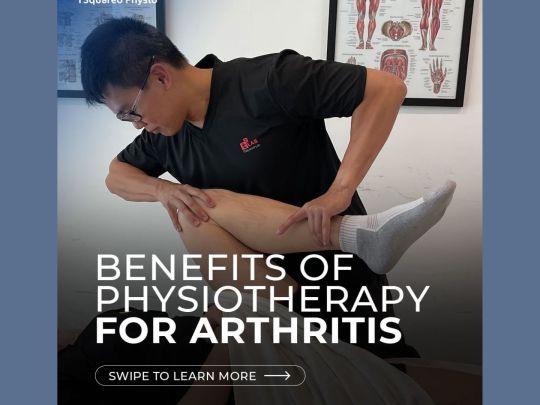
Living with arthritis can be challenging. It brings in the body, pain, stiffness, and reduced mobility. While on one hand, medications can provide relief, it becomes not entirely curable in the long. But on the other hand, you can try using physiotherapy as it offers additional benefits that may not be immediately obvious.
In this blog, we'll uncover four surprising benefits of physiotherapy for arthritis that go beyond pain management and joint exercises.
The Hidden 4 Benefits of Physiotherapy for Arthritis
Arthritis is one of the most common problems people face on an everyday basis. Besides causing pain, it stands as the reason why people face issues like reduced mobility and eventually, that leads to a degradation in their entire well-being. Here’s how you can use physiotherapy as an ailment for your arthritis issues:
Joint Mobility and Flexibility
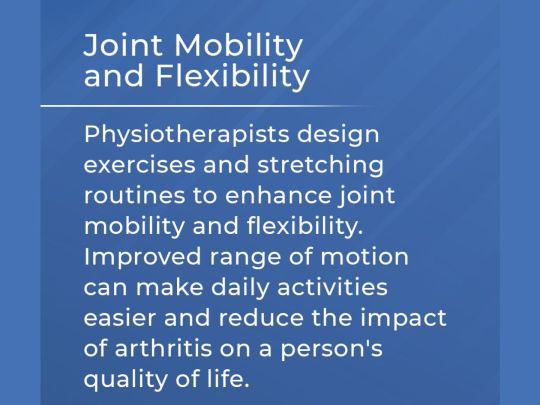
Physiotherapy focuses on improving joint mobility and flexibility through targeted exercises and stretching routines. For an arthritis patient, you might have painful joints that would not provide you the strength the move on a general basis and this would help you. These exercises help lubricate the joints, reduce stiffness, and increase the range of motion. By enhancing joint function, physiotherapy gives the smooth ability to arthritis patients to perform daily activities with greater ease and comfort and lesser pain eventually.
Weight Management

Excess weight increases symptoms by placing additional stress on the joints. This leads to increased pain and inflammation. Physiotherapy isn’t just a set of exercises but it also provides education and guidance on weight management strategies, such as dietary modifications and personalized exercise plans. It would help you balance weight. And thus, in the long run, alleviate arthritis pain.
Posture and Body Mechanics

Poor posture and improper body mechanics can actually contribute to joint strain and exacerbate arthritis symptoms. Physiotherapy addresses these issues in a way. It teaches you proper body mechanics and posture techniques. By such optimization of body alignment and movement patterns, arthritis patients can reduce joint stress and minimize pain during daily activities.
Psychological Well-Being

Living with chronic pain and limited mobility can take a toll on mental health, leading to feelings of frustration, anxiety, and depression. Physiotherapy provides a supportive environment where arthritis patients can receive emotional encouragement and coping strategies. Engaging in regular physical activity also releases endorphins, which are natural mood boosters, promoting a positive outlook and improved psychological well-being.
FAQs on Benefits of Physiotherapy for Arthritis:
Is physiotherapy safe for all types of arthritis?
Physiotherapy can be beneficial for various types of arthritis, including osteoarthritis, rheumatoid arthritis, and psoriatic arthritis. However, treatment approaches may vary depending on the specific type and severity of arthritis. It's essential to consult with a qualified physiotherapist who can tailor the treatment plan to individual needs and conditions.
How long does it take to see results from physiotherapy for arthritis?
The timeline for seeing results from physiotherapy can vary depending on factors such as the severity of arthritis, adherence to the treatment plan, and individual response to therapy. Some patients may experience improvement in symptoms within a few weeks, while others may require longer-term therapy for sustained benefits.
Can physiotherapy prevent arthritis progression?
While physiotherapy cannot cure arthritis, it can help manage symptoms, slow disease progression, and improve overall function and quality of life. By addressing underlying factors such as joint stiffness, muscle weakness, and poor posture, physiotherapy aims to minimize the impact of arthritis on daily activities and joint health.
Learn about the importance of posture and body mechanics to minimise joint strain, and discover how physiotherapy contributes not only to physical well-being but also to psychological health.
Embrace a comprehensive approach to arthritis care with personalised exercises, weight management, and mental well-being support from skilled physiotherapists at TSquared Physiotherapy.
Book your first appointment with us today!
0 notes
Text
The Benefits of Physiotherapy for Senior Citizens That Reduce Stress
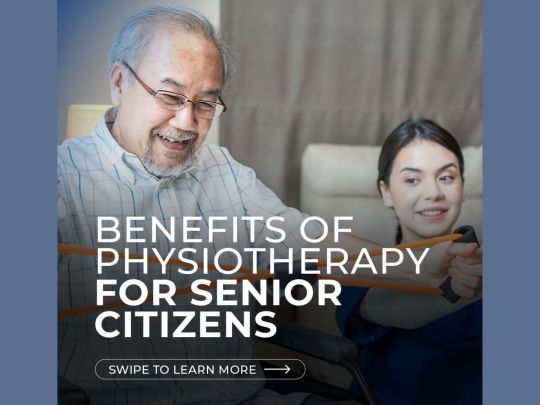
As we age, we find that maintaining physical health becomes an issue over time. And thus, working on it seems like a must, to alleviate oneself from pain and all the other health issues. You generally look for options to help you. For some, it can be exercise, while others resort to therapy. In that sense, physiotherapy offers a holistic approach. It helps you to improve mobility, manage pain, and enhance quality of life. That’s why in this blog, we'll delve into the four best benefits of physiotherapy for senior citizens, with a particular focus on how these benefits contribute to stress reduction.
The 4 Best Benefits of Physiotherapy for Senior Citizens
Senior citizens must not be treated as young adults. They have a whole different set of issues that would have to be fixed otherwise in the long run they might be continuously on the run to fix it. Keeping in mind such a fact, one has to remember while working with a senior citizen, you must have a different approach to physiotherapy:
Pain Management
Chronic pain is a common issue among senior citizens. This often leads to decreased mobility and reduced quality of life. Physiotherapy employs various techniques that include targeted exercises, manual therapy, and modalities like heat and cold therapy, to manage pain effectively. Once you address the root cause of pain and promote healing, physiotherapy can significantly reduce stress associated with chronic discomfort.
Improved Mobility and Flexibility
Age-related issues cause changes in joints, muscles, and bones and can impact mobility and flexibility, making everyday activities challenging and frustrating. Physiotherapy can be the solution to such issues since it focuses on restoring and enhancing movement through tailored exercise programs and stretches. By improving mobility and flexibility, seniors can regain independence, which can alleviate stress related to feelings of dependency and limitation.
Prevents the Risk of Falls
Falling randomly is a significant concern for senior citizens and can lead to serious injuries and loss of confidence. And this mainly arises from the fact they don't have enough strength to grip onto something. It is a hidden mobility issue most senior citizens face. Physiotherapyplays a crucial role in fall prevention by assessing balance, strength, and gait, and implementing exercises to improve these areas. Enhancing balance and coordination can reduce the risk of falls, providing seniors with peace of mind and reducing stress associated with the fear of falling.
Rehabilitation after Surgery or Injury
Surgery or injury can significantly impact a senior's physical function and quality of life. Physiotherapy is deemed essential in the rehabilitation process because it helps seniors regain strength, mobility, and function following surgery or injury. Through personalized rehabilitation programs which are tailored to an individual’s needs, since each surgery requires a different approach and in this way, physiotherapists guide seniors through exercises and therapies to promote recovery and restore independence.
Summary
Physiotherapy is a therapy that offers numerous benefits for senior citizens, ranging from pain management and improved mobility to fall prevention and rehabilitation after surgery or injury. By addressing these aspects of physical health, physiotherapy contributes to stress reduction by enhancing quality of life, promoting independence, and restoring confidence in seniors' abilities to navigate daily activities.
FAQs on the Benefits of Physiotherapy for Senior Citizens
How often should senior citizens undergo physiotherapy sessions?
The frequency of physiotherapy sessions for seniors depends on individual needs, health conditions, and treatment goals. Generally, initial sessions may be more frequent, gradually tapering off as progress is made. A physiotherapist will assess each senior's situation and recommend an appropriate treatment plan.
Is physiotherapy suitable for all senior citizens, regardless of their physical condition?
Physiotherapy can benefit most senior citizens, but the treatment approach may vary based on individual health conditions and limitations. A qualified physiotherapist will conduct a thorough assessment to determine the most suitable interventions for each senior, ensuring safe and effective treatment.
Can physiotherapy help with cognitive health in addition to physical health?
While physiotherapy primarily focuses on physical rehabilitation and function, certain interventions may indirectly benefit cognitive health. Improved mobility, increased social interaction during therapy sessions, and enhanced overall well-being can have positive effects on cognitive function. However, specific cognitive therapy may be required for seniors with cognitive impairments.
Learn more at TSquared Physiotherapy Blog
0 notes
Text
Did You Know About These 3 Benefits of Massage Therapy?

Massage therapy is often seen as a luxurious indulgence, which shouldbe reserved for special occasions or spa days. But that is never the case. Beyond the relaxation it offers, massage therapy holds numerous benefits for both physical and mental health. And there are numerous ways physiotherapy can be beneficial. But most of them are hidden and not known to many. Thus, in this blog, we'll explore three surprising benefits of massage therapy that you may notbe aware of.
The 3 Benefits of Massage Therapy You Didn’t Know Of!
Now there are a bunch of benefits that can be gained from physiotherapy. The most important of them all is the growth of overall well-being. But let’s take a look at the ones so rarely heard of:
Boosts the Immune System
Massage therapy has been, over the years, found people being aided with a relaxing moment. But there’s more to just that. There’s a lot of research that suggests that regular massage sessions can increase the activity level of white blood cells, which play a crucial role in defending the body against illness and disease. By working on the immune function of the body, massage therapy can also help you stay healthier. In such a way, you will help yourself ward off common infections more effectively.
Helps in Reducing Stress
One of the most well-known benefits of massage therapy is its ability to reduce stress levels. Beyond the therapy being a temporary escape from the pressures of daily life, it also has another work. Massage has been shown to lower the body's cortisol levels while increasing the production of serotonin and dopamine, neurotransmitters which are associated with feelings of relaxation and well-being. This can thus, lead to long-term stress reduction and improved mental health.
Improvement in Sleep Cycle
If you struggle with sleep disturbances or insomnia, massage therapy may offer some relief. This is another benefit you didn’t know would exist. It is proven that massage can help promote relaxation and alleviate muscle tension, leading to improved sleep quality. This works by calming the nervous system and inducing a state of relaxation. And that is the way massage therapy can help you fall asleep faster, stay asleep longer, and feel refreshed.
Why is Massage Therapy Important?
Massage therapy is quite important because it actually addresses both physical and mental aspects of well-being, leading to the promotion of overall well-being. In today's fast-paced world, where stress and tension are prevalent, taking care of both our bodies and minds is quite essential for maintaining overall health and vitality. By incorporating massage therapy into your self-care routine, you can reap benefits like improved immune function, reduced stress, and better sleep that would ultimately lead to a happier and healthier life.
FAQs
How often should I get a massage for maximum benefits?
The frequency of massage therapy sessions can vary depending on individual needs and preferences. Some people may benefit from weekly sessions, while others may find that bi-weekly or monthly massages suffice. It's essential to listen to your body and consult with a qualified massage therapist to determine the optimal frequency for you.
Are there any contraindications for massage therapy?
While massage therapy is generally safe for most people, there are certain conditions for which massage may not be recommended or may require modifications. These include certain medical conditions, recent injuries, or acute illnesses. It's crucial to inform your massage therapist about any health concerns or conditions you have, to ensure a safe and effective treatment.
What type of massage is best for stress relief?
Various types of massage, such as Swedish massage, deep tissue massage, and aromatherapy massage, can effectively relieve stress. The best type of massage for you will depend on your specific preferences and needs. It's importantto communicate with your massage therapist about your goals for the session so they can tailor the treatment accordingly.
0 notes
Text
5 Transformative Benefits of Stretch Therapy
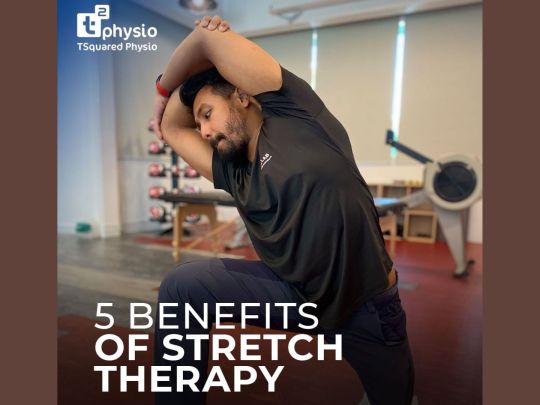
Stretch Therapy is like giving your body a big, warm hug.
Did you know the benefits of stretch therapy?
Stretch therapy is all about boosting flexibility, movement, and feeling great from head to toe through some seriously awesome stretching techniques. Stretch therapy is all about getting your muscles moving in fun and dynamic ways- something that can promote your overall well-being.
Do you know how it promotes overall well-being? It's packed with a bunch of benefits you didn’t know of. First off, it helps you get super bendy and flexible, so you can move with enhanced muscular coordination and avoid those pesky injuries. Plus, it's like hitting the reset button for your muscles, melting away tension and helping you feel relaxed and laid back.
By targeting those tight spots and giving your muscles some love, stretch therapy can have you standing tall and having a great posture at the same time.
But there are a few more benefits to this form of therapy, let’s have a look into that.
Benefits Of Stretch Therapy You Should Know of
Stretch therapy has quite a few advantages. But unfortunately, it is heavily misunderstood and undervalued. Let’s look into those benefits most people ignore:
Better Muscle Coordination
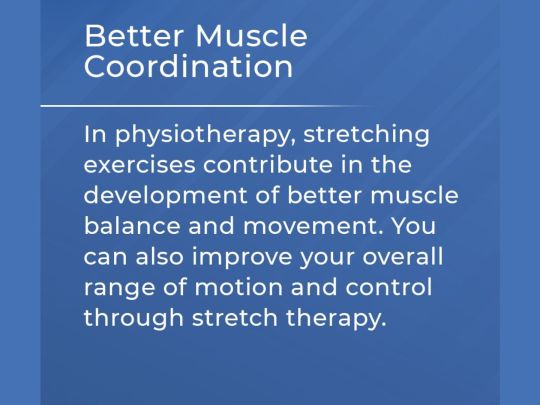
Stretch therapy enhances muscle coordination by promoting better communication between muscles and nerves. Through targeted stretches, you engage various muscle groups, encouraging them to work together more efficiently. This coordination not only improves athletic performance but also reduces the risk of injury during physical activities.
Your muscles are just like a team of synchronized dancers, moving in harmony to perform a flawless routine. Stretch therapy helps them rehearse and perfect their moves, ensuring smooth and coordinated actions in all your activities.
Improvement of Blood Circulation and Nutrition Supply

Stretching increases blood flow towards your muscles, delivering essential nutrients and oxygen while removing waste products. This enhanced circulation supports muscle recovery and repair, leading to faster healing and reduced soreness after exercise.
Think of stretching as a refreshing drink for your muscles. With each stretch, you're a lot more than you imagine- nourishing them with a rush of revitalizing nutrients, leaving them feeling energised and ready for action.
Improved Flexibility
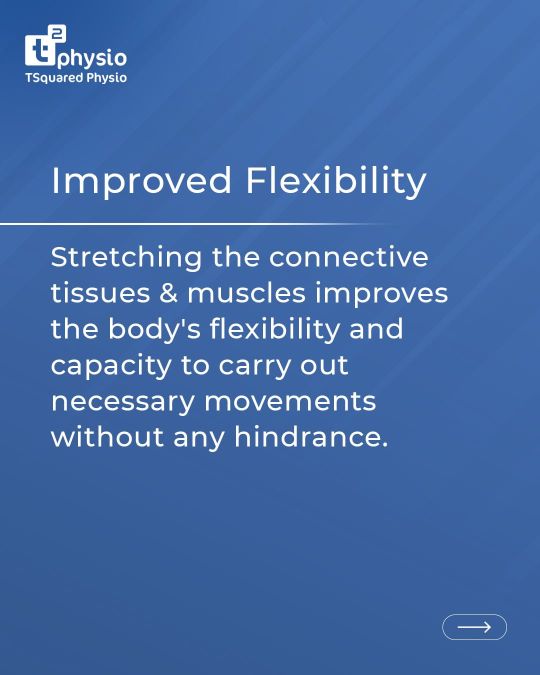
Regular stretching sessions gradually increase flexibility by elongating muscles and improving their elasticity. This enhanced flexibility allows for a greater range of motion and reduces muscle tension and stiffness, leading to improved mobility and agility.
It’s like placing yourself as a graceful gymnast, effortlessly bending and stretching with fluidity and ease. Stretch therapy helps you achieve that same level of flexibility, allowing you to move through life with grace and agility.
Better Posture
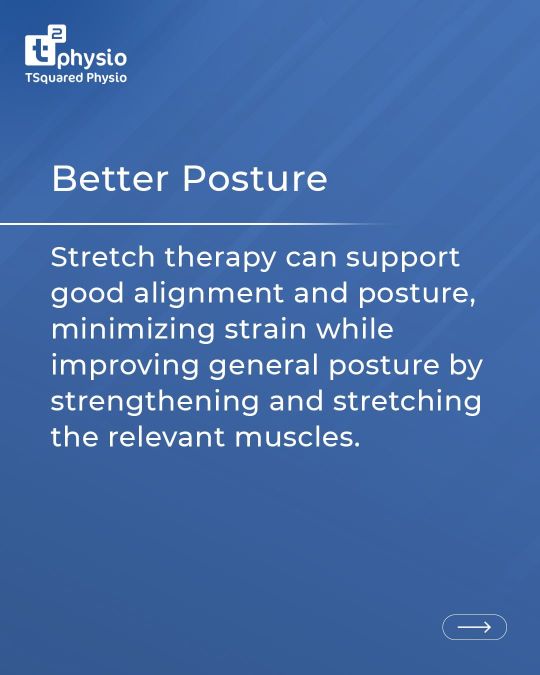
Stretch therapy targets key muscle groups responsible for maintaining proper posture, such as the back, shoulders, and hips. By releasing tension and tightness in these areas, stretching helps correct imbalances and alignment issues, resulting in improved posture and reduced risk of back pain.
Imagine standing tall and proud, with your shoulders back and head held high. Stretch therapy helps you achieve that confident posture, giving you the poise and presence to tackle whatever life throws your way.
Stress Management and Relaxation
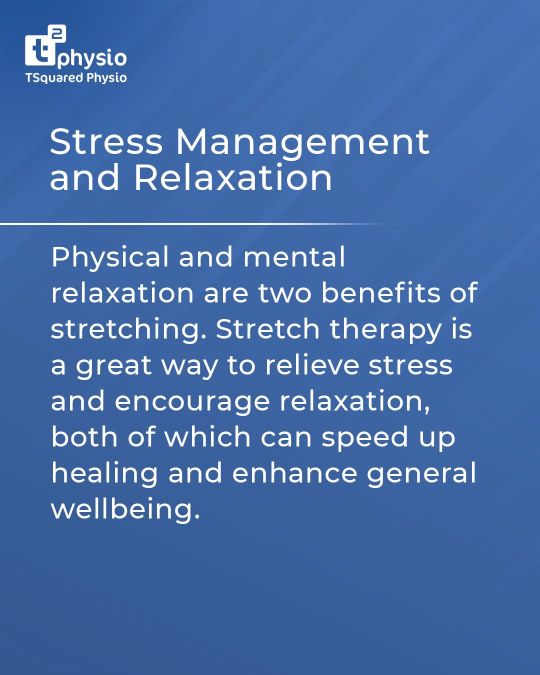
Stretching promotes relaxation by triggering the release of endorphins, the body's natural feel-good hormones. This calming effect reduces stress levels and promotes well-being, helping you unwind and de-stress after a long day.
We’ll tell you an easier way to do this. Close your eyes and take a deep breath as you sink into a gentle stretch. Feel the tension melt away from your body, leaving you feeling calm, centred, and ready to take on the world.
Now that you already know about the benefits of stretch therapy, it’s easier for you to get into it. So why wait and waste time? in theapy everyday can get you going good in the long run. Let’s hop into your stretch journey and hope it keeps you well.
0 notes